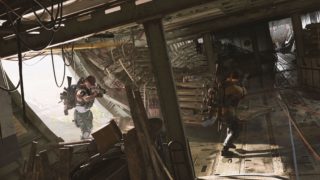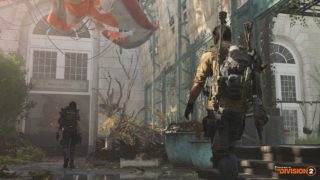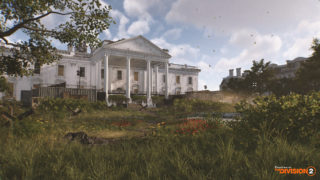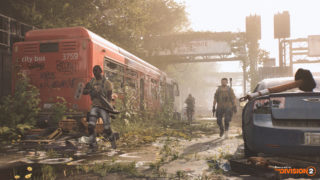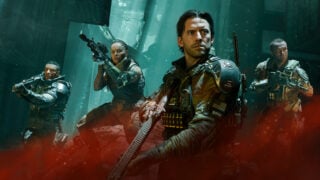Launch Review: The Division 2 is a loot shooter with little to say
Ubisoft’s expansive shooter offers slick thrills, but has little to say
- Creative Director
- Julian Gerighty
- Key Credits
- Chadi El Zibaoui (Associate Creative Director), Benedikt Podlesnigg (Art Director)

Disclaimer: This is a launch review of a large service game that is likely to receive significant post-launch content. As such the game experience is likely to evolve as the game’s developer adds and changes its systems over the following months and years. This review is accurate as of the launch window.
For all the deafening noise and fury of its street battles and set-pieces, The Division 2 is, at heart, a game of co-operative tidying up with incrementally better guns.
Ubisoft’s slick, expansive looter-shooter (a term that works on two levels, since many of the people you’re shooting are basically looters) feels like a muscular show of force, arriving on the heels of EA’s buggy, flimsy Anthem to show how this sort of thing should be done. In fairness, developer Massive Entertainment has had the benefit of a practice run. But The Division 2 has clearly learned from the mistakes of its predecessor. It’s a numbers game that, by and large, gets its sums right.

And so, after a hilariously overwrought bit of scene-setting, you’ll find yourself sweeping across a handsomely ruined post-pandemic Washington DC, gently exfoliating the map to clear away its nasty case of icon acne. You’ll retrieve tech caches, knock off small enemy patrols and hold X to relieve large briefcases, medium suitcases and the odd rucksack of their contents.
Even on scripted assignments, you’ll take a methodical approach, going from room to room, emptying each of enemies and then clearing away after yourself by scooping up the gear and consumables they leave behind.
For all that firefights often reach a feverish intensity, the core gameplay loop has an oddly therapeutic quality – at least when you’re playing in a group. For large parts of the game (certainly for the duration of the campaign) it’s vastly easier when there’s four of you – even in a team of randoms with no comms.
When your enemy has just one target to aim at, you’ll find yourself up against it – you might hunker down behind impenetrable cover, but on one side you’ll have a melee attackers sprinting your way while a dude with a shotgun flanks you from the other side and a grenade lobber with alarmingly good aim tries to flush you out.
With checkpoints and restocks between rooms, it’s doable alone, but given you level up quicker as part of a group you’re always better off with at least one partner. In fact, two feels like a sweet spot for many missions: it’s more tense than with a full squad, with fewer second chances. When one of you gets badly wounded and needs to drag themselves to cover to be revived, the other is suddenly, frighteningly exposed.
But with three others? You’ll steam through these sequences without too much trouble. Here you’re more likely to notice that the enemy, seemingly so intelligent when you’re on your own, can actually be quite stupid at times, sprinting suicidally into the open, and sometimes staying so intently focused on a single target that you can casually stroll up to them and shotgun them in the head without them even glancing around.
Having two special abilities on cooldowns make The Division 2 more than a mere stop-and-pop, though it’s only when you’re working with friends with complementary abilities that you’ll seriously think about how you use them. Mostly, it’s just a case of waiting for the timer to tick back down and then tapping one or both bumpers.
You can equip a pulse that highlights local threats, a weird drone thing that can heal or revive allies, and a shield, with three variants of each. It’s fleetingly fun to watch enemies get stuck up with riot foam or to surround them with a chemical cloud that can be lit up for a fiery finisher. But really, it’s all about the drones and turrets.
“The Division 2 has clearly learned from the mistakes of its predecessor. It’s a numbers game that, by and large, gets its sums right.”
The former will follow you around, prioritising targets unless you direct it to focus on a particular one. With the latter, meanwhile, you’ll spend far too much time adjusting your aiming arc so it lands in the most tactically advantageous spot. If you can get it on a gantry, you’re laughing; on one mission we managed to land ours on a giant spinning globe and the enemies didn’t know what had hit them. Both are ludicrously effective distractions in a game where you’re always safest when your opponent is looking in another direction.
There are plenty of entertaining moments like this in the story missions, which boast a clutch of enjoyably chaotic set-pieces. For presentation alone, a shootout in DC’s Air and Space Museum is an early candidate for 2019’s best action sequence.
The Division 2 is at its best when your motivation is to simply keep yourself and your buddies alive, because it does a terrible job of making you care. Its pitiful story, populated by hollow characters and studded with meaningless terminology, is so forgettable that halfway through the story missions we realised we had no idea what we were doing or who for.

But then it seems The Division 2 would prefer it that way. Plenty of video games are about playing a good guy with a gun who must stop bad guys with guns (there are female avatars, but annoyingly, enemy barks only ever refer to you as ‘he’ and ‘him’) but none has leaned so heavily on such loaded imagery.
This is a game where the White House has been repurposed into a central base of operations, where you blast your way through a museum exhibit celebrating the Vietnam War, and where at one point you’re asked to retrieve the Declaration of Independence “to remind everyone what we’re fighting for”. Its patriotic fervour is undeniable, yet so much of it amounts to nothing more than window dressing.
Still, some moments left us feeling decidedly uneasy: we talk about faceless bad guys in games, and The Division 2 takes this to extremes. You’ll never see the whites of your opponent’s eyes because their faces are usually almost entirely covered. Shades and bandanas render each one anonymous, while you, looking for all the world like part of a well-armed, well-armoured, well-funded PMC, become acutely aware that you’re actually the Goliath to their scrawny David. Yet you’re presented as the hero of the hour, with endless verbal reinforcement that you’re doing the right thing – even if everyone constantly addresses you, in weirdly impersonal fashion, as “Agent”.
“The Division 2’s players seem to be having a good time in general: having spent most of our time matchmaking with randoms, we can confidently say this is one of the most pleasant online communities we’ve encountered.”
While it demands you hold your nose at times, there are signs that you’re making some kind of positive contribution. As you tick off more boxes on an increasing number of checklists, your goals are reflected in how friendly settlements develop – complete objectives and donate spare gear and the next time you visit, you’ll see new solar panels, a videogame corner, and a firing range to test out that new gun that produces slightly bigger numbers than the last one.
You may not feel any meaningful connection to it, because the only people you’ll interact with are vendors and mission-givers. But it’s a sign that you’re at least bringing a bit of joy to a few residents of the besieged capital.

The Division 2’s players also seem to be having a good time in general: having spent most of our time matchmaking with randoms, we can confidently say this is one of the most pleasant online communities we’ve encountered. Almost everyone silently goes about their business, instinctively helping one another through difficult situations, and politely thanking one another in text chat.
We’ve had a few technical issues – notably, the penultimate objective of a long mission failed to trigger on two occasions – but happily, scripting issues like this don’t seem too common. Service games can often launch in a terrible state before steadily being patched up; one or two oddities aside, there’s far less to fault The Division 2 in that regard than many of its peers.
It’s generous, too, with an endgame that is substantial in size, if not in variety – though the fractious atmosphere of the PVP elements is an appealing alternative to the steady accrual of marginally better kit to deal with increasingly spongey opponents. If few can reasonably complain about the sheer volume of stuff in The Division 2, it ultimately feels like an all-you-can-eat buffet of gourmet junk food. It’s keen to impress you with the size of its spread – and to make sure you’re too busy wolfing it down to realise it’s probably not doing you much good.
For all the deafening noise and fury of its street battles and set-pieces, The Division 2 is, at heart, a game of co-operative tidying up with incrementally better guns.
- Undeniably moreish, with plenty to keep nibbling at
- A solid mix of set-pieces and dynamic sandbox asides
- Open world is rich, detailed and gorgeously lit
- A dreadful story with nothing to say
- Repetitive and exacting when playing alone






